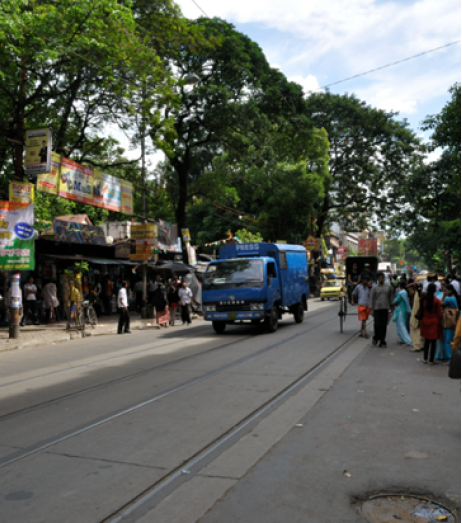A concrete road, etched with tram lines and dotted with bookstores that spill onto footpaths and is home to universities, College Street, in central Kolkata has a history with revolutions, education and adda. Here in the by lane opposite Presidency College, stands a greyish-white, building with one door stating that this is the Indian Coffee House. Partly obscured by hoardings and wires, stands tall the personification of Bengali Intellectualism, the Indian Coffee House. As you enter the almost nondescript building, the stairs grab your attention. The walls are adorned with graffiti and posters, where Marx occupies place of honour besides Gandhi. As you mount the short stepped wide staircase you feel goosebumps as you become aware that these very stairs with their broken hairlines resounding with the footfalls of the likes of Netaji, Chittaranjan Das and Ashutosh Mukherjee.

Entrance of the Indian Coffee House
As one enters the large hall of the ground floor, numerous tables, each surrounded by four arm chairs are seen. Waiters smartly dressed in white with red sash and red turbans manage the tables serving cups of steaming tea or coffee with perfect balance and poise. The hall vibrates with a constant hum of unceasing conversation interspersed with occasional laughs, giggles or shrill notes of discord. This is the birth place of pathbreaking ideas in politics, movies, art and culture. So many disruptions and revolutions were fomented within these walls, accompanied by the spiralling cigarette smoke puffed over innumerable cups of strong tea. The Indian Coffee House has been the womb of the Naxalite movement, a movement that threatened to wipe out an entire generation of the educated Bengali youth.
As a café, its food is probably the least talked about. The unapologetically strong black coffee here is well known to serve as a stimulant for nascent poetry and story plots. In this non-vegetarian restaurant, chicken pakora is a must accompaniment to the addas and impromptu musical jam sessions. This pre-independence era eatery offers a range of both Western and Eastern food.
It has no official branches though you may find a restaurant or two with a similar name in Kolkata. The Indian Coffee House is maintained by a cooperative of employees. Quite distinct compared to the capital world, isn’t it?

College Street with book shops

The Halls of the Indian Coffee House
The first floor of the Coffee House is actually a square balcony overlooking the ground floor on all sides. Both the floors have a common high ceiling as was the architectural tradition in those days. The authorities have maintained the original structure despite many changes in the facade of Kolkata over time. It is this place where time stands still and you can feel the embrace of the past, whispered planning of daring escapades, zombie boot stomps of charging British battalions, a mummified glory of colonial Bengal. The greyish walls, cobwebs and the ill maintained furniture may dishearten you but history in shambles is always a soothing depart from suave modernism.
The Indian Coffee House holds a special place in the heart of a true born Kolkata Bengali which is why the prolific singer Manna Dey dedicated one of his most popular songs to the Coffee House adda!
So, do you care for a cup of coffee in the Indian Coffee House?

